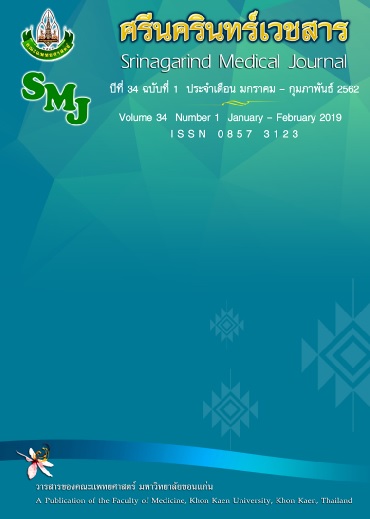The Correlation between Percutaneous Length of Fibula and Stature of Ubon Ratchathani University Students
Keywords:
stature; correlation; percutaneous; length; fibulaAbstract
Background and Objective: The stature is one of the important biological profiles of an individual and associated with personal identification. The fibula is easily percutaneously palpable and non-weight-bearing bone due to no direct articulation from the femur. Therefore, the fibula is no changing of length from increasing body weight. This study aimed to assess the correlation between percutaneous length of fibula and stature in young adult Northeastern Thais; Ubon Ratchathani University students.
Methods: The subjects were all Thai healthy students (179 males and 168 females) from College of Medicine and Public Health, Ubon Ratchathani University. The ages were ranged from 19 to 22 years. The percutaneous lengths of fibula were measured between proximal end of fibular head and distal end of lateral malleolus. Left and right percutaneous lengths of fibula of each subject were measured. The stature was also measured in standing position. The data were statistically analyzed using independent t-test. The correlation between percutaneous length of fibula and stature was tested by Pearson correlation analysis.
Results: The mean stature of males (170.5 ± 6.8 cm) was significantly higher than that of females (158.4 ± 6 cm) (p<0.05). The mean of percutaneous lengths of fibula of males (left side 39 ± 2.5 cm and right side 38.9 ± 2.6 cm) was significantly longer that of females (left side 36.6 ± 2 cm and right side 36.4 ± 2.1cm) (p<0.05). Bilateral difference of percutaneous lengths of fibula was not significant (p>0.05). The percutaneous lengths of fibula showed significant positive correlation with stature in both genders.
Conclusion: The percutaneous lengths of fibula were positively correlated with the stature in young adult Thais; Ubon Ratchathani University students. This study was basic data to develop the stature equation for personal identification in young adult Northeastern Thais.
References
dimensions by regression analysis in Indo-Mauritian population. Journal of Forensic and Legal Medicine; 18 (2011): 167-72.
2. Krishan K, Kumar R. Determination of stature from cephalo-facial dimensions in a North Indian
population, Leg Med 2007; 9: 128–33.
3. Nagesh KR, Pradeep Kumar G. Estimation of stature from vertebral column length in South Indians.
Leg Med 2006; 8(5): 269-72.
4. Torimitsu S, Makino Y, Saitoh H, Ishii N, Hayakawa M, Yajima D, et al. Stature estimation in Japanese
cadavers using the sacral and coccygeal length measured with multidetector computed tomography. Leg Med 2014; 16(1): 14-9.
5. Mahakkanukrauh P, Khanpetch P, Prasitwattanseree S, Vichairat K, Case DT. Stature estimation from
long bone lengths in a Thai population. Forensic Sci Int 2011; 210(1-3): 279.e1-7.
6. Giurazza F, Del Vescovo R, Schena E, Battisti S, Cazzato RL, Grasso FR, et al. Determination of
stature from skeletal and skull measurements by CT scan evaluation. Forensic Sci Int 2012; 222(398): 1–9.
7. Torimitsu S, Makino Y, Saitoh H, Sakuma A, Ishii N, Hayakawa M, et al. Stature estimation based on radial and ulnar lengths using three-dimensional images from multidetector computed tomography in a Japanese population. Legal Medicine 2014; 16: 181–6.
8. Jee S, Yun MH. Estimation of stature from diversified hand anthropometric dimensions from Korean
population. Journal of Forensic and Legal Medicine 2015; 35: 9-14.
9. Uhrová P, Benuš R, Masnicová S, Obertová Z, Kramárová D, Kyselicová K et al. Estimation of stature
using hand and foot dimensions in Slovak adults. Legal Medicine 2015; 17: 92–7.
10. Hatza AN, Ousley SD, Tuamsuk P. Stature Estimation in Modern Thais: Are Population-Specific
Estimation Equations Necessary? Proceeding of the 65th Annual Meeting of the American Academy of Forensic Sciences; 2013 Feb 18-23; Washington DC; 2013.
11. Goliath JR, Stewart MC, Tuamsuk P. Stature Estimation from Modern Southeast Asian Skeletal
Remains: Placing the Data in Context. Proceeding of the 84th Annual Meeting of the American
Association of Physical Anthropologists; 2015 Mar 25-28; Missouri; 2015.
12. Dayal MR, Steyn M, Kuykendall KL. Stature estimation from bones of South African whites, south,
African journal of science 2008; 104: 3-4.
13. White TD, Folkens PA. The human bone manual. London: Elsevier Inc, 2005.
14. Gaur R, Kaur K, Airi R, Jarodia K. Estimation of Stature from Percutaneous Lengths of Tibia and
Fibula of Scheduled Castes of Haryana State, India. Ann Forensic Res Anal 2016; 3(1): 1-6.
15. Whiteman SD, McHale SM, Crouter AC. Family Relationships from Adolescence to Early Adulthood:
Changes in the Family System Following Firstborns’ Leaving Home. J Res Adolesc 2011; 21(2):
461–74.
16. Martin R, Saller K. Lehrbuch der Anthropologie. Stuttgart: Gustav Fischer Verlag, 1957.
17. NECTEC. SizeThailand. 2008 [online] [cited 2018 Aug 10] Available from:
http://www.sizethailand.org/region_all.html.
18. He X, Li Z, Tang X, Zhang L, Wang L, He Y, et al. Age- and sex-related differences in body
composition in healthy subjects aged 18 to 82 years. Medicine 2018; 97(25); 1-6.
19. Lemtur M, Rajlakshmi C, Devi ND. Estimation of Stature from Percutaneous Length of Ulna and
Tibia in Medical Students of Nagaland. IOSR Journal of Dental and Medical Sciences 2017; 16 (1): 46-52.
20. Hora M, Soumar L, Pontzer H, Sládek V. Body size and lower limb posture during walking in humans
2017; 12(2): 1-26.
21. Grasgruber P, Sebera M, Hrazdı´ra E, Cacek J, Kalina T. Major correlates of male height: A study of
105 countries. Econ Hum Biol 2016; 21: 172-95.
22. Ide Y, Matsunaga S, Harris J, O' Connell D, Seikaly H, Wolfaardt J. Anatomical examination of the
fibula: digital imaging study for osseointegrated implant installation. J Otolaryngol Head Neck Surg 2015; 44: 1.
23. Radoinova D, Tenekedjiev K, Yordanov Y. Stature estimation from long bone lengths in Bulgarians. Homo. 2002; 52:21-32.
24. Laurent M, Antonio L, Sinnesael M, Dubois V, Gielen E, Classens F, et al. Androgens and estrogens
in skeletal sexual dimorphism. Asian J Androl. 2014; 16(2): 213–22.




